
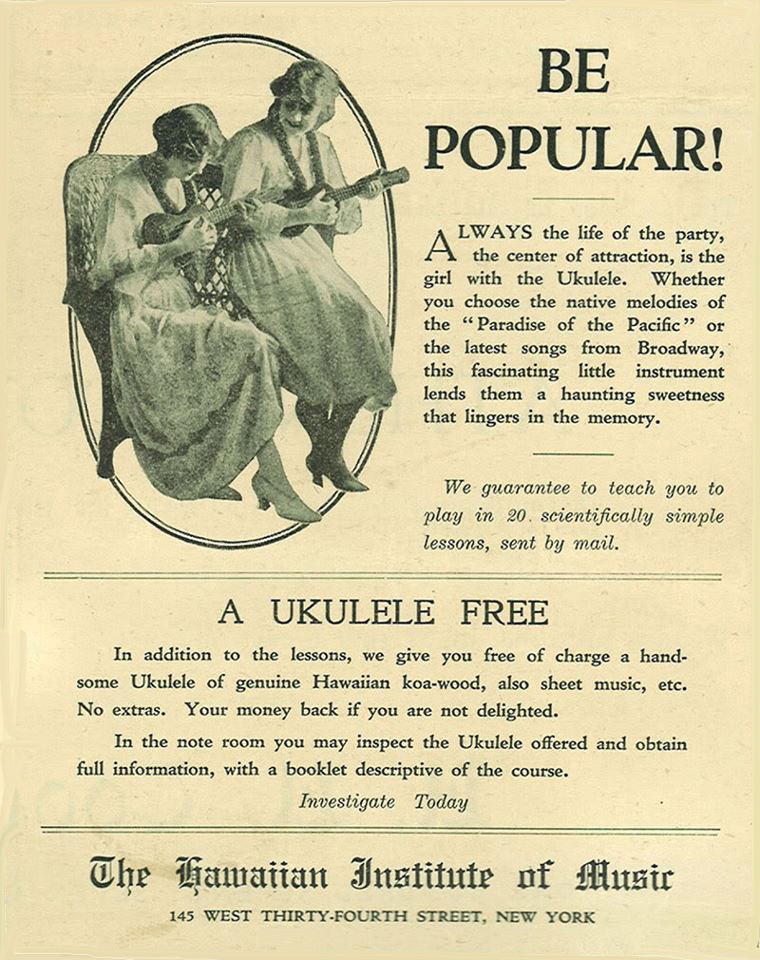
These images are stored in larger size. For a better visibility of the text from the pictures, drag a copy on your desk.
Sheets with chords
USA, ca. 1920/30
The traditional A-D-F#-B-tuning was standard then, To adapt to piano accompaniment, the authors recommend on the one hand, the re-tuning to C or, as appropriate to the accompaniment of wind instruments, even after Eb.
 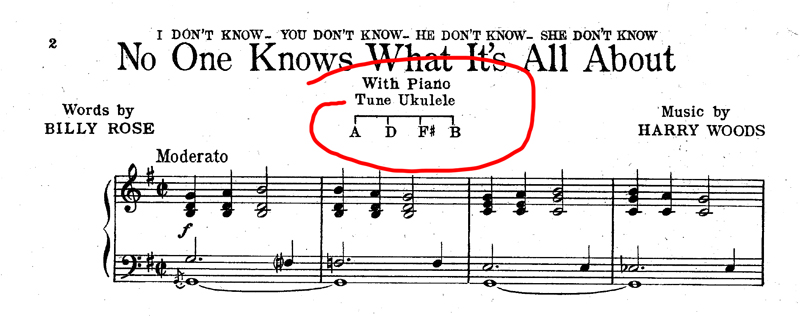
f.i. A-D-F#-B-tuning
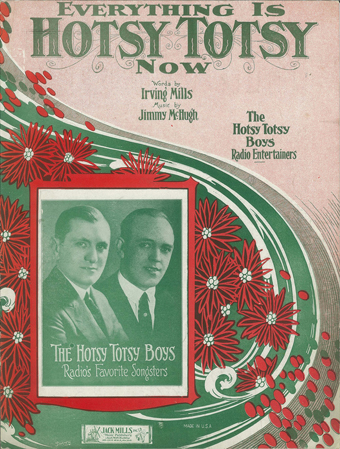

f.i. G-C-E-D-tuning


f.i. Bb-Eb-G-C-tuning
Ukulele in Germany,
during the Nazi years

The Tau Moe Family (Varieté Ronacher in Wien)
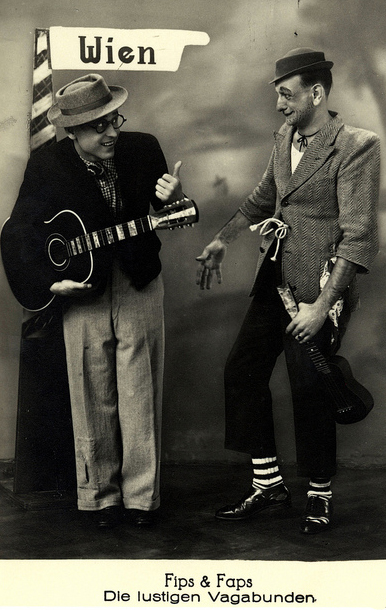
Fips & Faps (German Duo)
Historical instruction
books from Germany

ca 1927: "Wie lerne ich in 10 Stunden Ukulele spielen" - How do I learn playing ukulele in 10 hours...
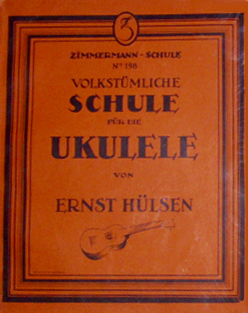 1928:
"Volkstümliche Schule für die Ukulele" - Popular instruction for Ukulele 1928:
"Volkstümliche Schule für die Ukulele" - Popular instruction for Ukulele
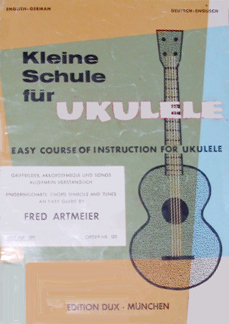
1963:
"Kleine Schule für Ukulele" - Little school for ukulele, a modified edition of this book, in German and English, is still available today.
|
|
Popularization of the Ukulele
U.S.
Two decades after the founding of the Republic of Hawaii (1894, followed later by U.S. Statehood in 1959), Hawaii, took part in a World's Fair in San Francisco - the inconspicuous exhibit of 1915: a ukulele. Hawaiian musicians aroused the interest in exotic instruments, including the Royal Hawaiian Quartet and Jonah Kumalae who was a ukulele builder. 1915 is considered the year the ukulele swept the USA, but the ukulele has been already present in Chicago in 1893.
In the 1920s the ukule was already being played in many jazz bands. The legendary players of this era include Cliff Edwards aka "Ukulele Ike", and the virtuoso Roy Smeck. Later, as it became more and more popular in the United States, the guitar manufacturer Martin started producing ukuleles in 1926. Martin started selling ukuleles for $60 which was quite a bit of money back then. An ukulele textbook from the "roaring 20's" time advertises with the observation that the ukulele girl was "Always the life of the party, the center of attraction". As accesory of Pinup Girls, the ukulele also was put in the lockers of the soldiers.
Pacific - Asia - Australia - New Zealand
From Hawaii and the U.S. the ukulele has been spreading to the Pacific region, then probably from Japan to Southeast Asia: South Korea, Singapore and Thailand are now strongholds of the ukulele. China as a low-cost producer contributes further ... Since 2010, The Melbourne Ukulele Festival brings together the enthusiasm of Australia in every March. In New Zealand the ukulele spring of the Southern See starts every October at Hawke's Bay Ukulele Festival.
Europe
The ukulele reached the UK early in the 1920s, and with famous British actor George Formby occurs simultaneously in the television age, as it became standard at any skiffle band, the Beatles George Harrison and Paul McCartney were known to play the ukulele privately. The Hollywood classic "Some Like It Hot" (1959) brings ukulele player Sugar Kane (Marilyn Monroe) in the center of a comic film scene, where Prohibition era gangsters are seen. From that time on, everybody in Europe who has watched the film, knew what a "Jukulele" was - the German dubbing created a new word from the Americanized and the Hawaiian pronunciation.
Although the ukulele already has a long tradition in England, there is currently a revival. Since a few years, annual events like The Ukulele Festival of Great Britain (early June) or The London Ukulele Festival attract thousands of people. The fans from Germany and Netherland meet to "The Ukulele Hotspot Winterswijk" (mid May), the FIUL - Festival International de Ukulélé de Lerrain - in France has become another hot spot (early June). in Finland "The International Ukulele Festival" is celebratd every second year (next in August 2013). There was a festival in Poland first time (March 2012).
Germany
Since the last few years, the ukulele is now in every music store in Germany: even in food discounters cheap imports from Asia were already in the "on sale" bins. The ukulele has been known in Germany for much longer than is generally assumed. In fact, German manufacturers were already building and selling ukuleles long before the big boom began in the United States. In a catalog of the World's Fair in Chicago in 1893 one can find the first pictures of small four-string "guitars" by the company of Paul Stark in Markneukirchen - the term ukulele was kept almost until the beginning of the 20th Century, in part, the ukulele was also called the "Hawaiian Mandolin". In a German magazine for instrument manufacturers ("Zeitschrift für Instrumentenbau", Leipzig Oct. 1. 1925) the author of the article makes reference to the fashion whims of the British "Society", as then the Prince of Wales accepted the exotic instrument, the music shops in London soon started sales of ukuleles, mostly from the US-based company of C.F. Martin, but also by Manuel Nunes from Honolulu, Hawaii.
The company Fritz Strobel in Klingental produced ukuleles in the years 1895-1905, besides a number of companies from Markneukirchen, where ukuleles were a specialty between 1923 to 1935 in addition to the regular program of guitars and other instruments. Most probably these were manufactured for export to the United States and Great Britain, where the ukulele was already much more popular. During the "Golden Twenties" Berlin was a Mecca for revue artists from around the world, therefore the ukulele would have appeared frequently on German stages in the Weimar Republic. By 1930 the duo "Fips & Faps - Die lustigen Vagabunden" (The Merry Vagabonds) was reasonably well known, one of the two brothers played ukulele. Also, there were at least 5 different editions of German instruction books from that time: 1925 (Merkelt), 1927 (Hülsen), 1928 (Gregorio), (1930) Buchert, 1931 (Vobersin), and 1945 (Fröhlin)!
Did the "Fuhrer" play ukulele? Sorry, this is NOT a serious question! Nothing is known about Hitler's musical ambitions, but "Negro music" was not known to the likes of the Nazis. However, there is a remarkable episode: The Hawaiian Ensemble Tau Moe Family at that time was on a world tour and performed also in the highest circles, so for Winston Churchil and in 1932 Mahatma Gandhi in India - and yes, during the late 1930s even in Germany! While Tau Moe (born in Samoa, 1908-2004) was a famous steel guitar player his son, Lani Moe (Tokyo, 1929-2002) learned to play the ukulele. The story is told, that he particpated (as a child) at a parade at the Mercedes from Hitler - this can be read in the English Wikipedia.
According to the report "Taj Mahal Foxtrot - The Story of Bombay's Jazz Age" by Naresh Fernandes, the meeting was "in Berlin, where they met Hitler at a fundraiser for orphans" - no exact date is given. According to Bob Brozman The Tau Moe Family toured through Egypt, Syria, Turky, Russia from 1936 to 1938, the last stop in Germany could have been in 1939, before the war...
The artists, however, could not protect themselves from the captors of the Gestapo, who soon learned that the Hawaiian musicians used their privileges to help Jews escape from Germany. Thanks to a tip from friends during a performance the musicians could escape through a rear exit at the last minute. The Tau Moe Family then travelled stayed in India from 1941 to 1947, in 1946 their daughter Dorian was born, The Tau Moe Family would later start performing as the as The Aloha Four. Then, in the movie "The Flower of Hawaii" (a musical, FRG 1953), the trio appears again in Germany - Moe singing in German "Ich bin nur ein Neger" ("I'm just a nigger"). The tour of the Tau Moe Familiy started in 1927, has become an Odyssey during the war, and has brought them all around the world, the voyage finally lasted almost six decades! Moe's wife Rose died in 1998 (to other accounts in 2000), his son Lani died in 2002, Tau followed in 2004 at age 95.
After World War II, there were other problems in Germany which delayed the revival of the early ukulele tradition. But in 1950 and in 1963 there were a few editions of instruction books, the latter one is available from the publisher Edition DUX as a revised edition today. The bilingual booklet (which dispenses in contrast to many other contemporary pamphlets on kitschy illustrations) refers to the traditional Hawaiian tuning A-D-F#-B, while in the Anglo-Saxon world the G-C-E-A tuning is mentioned as "standard" or so-called "Hawaiian tuning". The Bavarian company Kollitz, known by the brand ukuleles "Brüko" also refers to a tradition since the 1930s, according to the models the traditional D-tuning is still prefered, but could be used with special strings for the C-tuning also. In the GDR, during a visit to a music store in the 1980's, there was, to my knowledge, neither manufacturers of ukuleles nor any imports for sale.
After the Berlin Wall came down, the ukulele slowly won more territory. During the early 1990s ukuleles were still rare in German music stores. As for me, I discovered the ukulele for the first time in the mid 1990s (at a concert by the U.S. musician Taj Mahal in Berlin - and the next day in the music store I bought an ukulele (and I began to disregard my 12-string Washburn guitar). A few TV presenters were occasionally seen with ukulele, which might have from the late 1990s triggered a first thrust into the music business.
Since summer of 2005 there is the "1. Deutscher Ukuleleclub" - a child of the Internet age. With increasing resonance the virtual club combines the interests of scattered living enthusiasts, organizes regional meetings, called "Ukulele Hot Spots". Several thousand fans of the ukulele chat in topic blogs, arrange themselves to festivals and other events. And sometimes there even meet a few "ukulelogists" and dig out very interesting facts about the amazing history of the ukulele in Germany from old books, catalogs, or museums ...
Meanwhile many online shops have adapted to the growing interest. From Amazon to eBay, the provider earn rapid on ukulele recovery. Additionally, in Berlin, in the bustling city of Kreuzberg district, a real store opened in early 2010, named "Leleland", dedicated exclusively to the ukulele. With a globally marketed posthumous hit (in the fall of 2010) the Hawaiian Israel Kamakawiwo'ole "Bruddah Iz" (Hawaii, 1959 - 1997) took the sound of the ukulele into every German living room. The ukulele has since overcome novelty status here: between Hamburg and Dresden, Berlin and Munich, there are hardly any white spots on the ukulele map.
* Many thanks for the information on historical German ukulele literature by Alex Müller, for cover photography by Peter Widemeyer, for translation into English by Robert Williams.
Web - Social Networks - Sales
Entering the term ukulele Google finds over 40 million hits at once - there is, of cource, clarification needed. In Youtube the same search indicates far more than a hundred thousand hits. Since 2009 the video "Mighty Uke" released an impression of the worldwide comeback of the ukulele. The global "ukulelizing" is reflected, of course, also on Facebook - those who can understand Thai language may "like" the pages of" UkuleleThai", nearly 50,000 subscribers have gathered there.
The global boom is manifested according to the sales of the music trade. In the U.S. alone, sales increased from 2009 to 2010, by a quarter. |

National Association of Music Merchants |
As for myself, I discovered the niche for myself in 2002, I began to offer individual and group lessons, first with tentative acceptance - ran my own ideas in schools and higher institutions into the void. So I founded my own "ukulele university" at home, not realizing that the ukulele a few years later achieved cult all media. Undoubtedly first appearances of the Ukulele Orchestra of Great Bitain have contributed. In exaggerating allusion to this eight-member ensemble, in 2005 I called my student chapel "Ukulele Orchestra Laubegast" (Laubegast is the lovely place where I live at the edge of Dresden). At peak times there were two dozen children, parents and grandparents on stage - which caused at various street festivals, of course, quite a stir. In August 2010 I started a little backyard Ukulele Festival at my home. And, of course, wherever I am on the road, I have my ukulele with me...
alles-uke.de
|
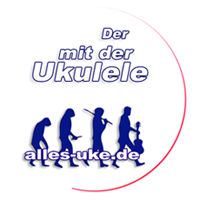
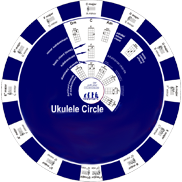










 1928:
"Volkstümliche Schule für die Ukulele" - Popular instruction for Ukulele
1928:
"Volkstümliche Schule für die Ukulele" - Popular instruction for Ukulele